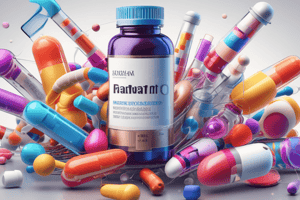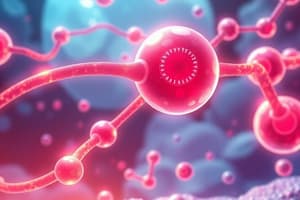Podcast
Questions and Answers
Which of the following routes of drug administration is least likely to provide a rapid onset of action?
Which of the following routes of drug administration is least likely to provide a rapid onset of action?
- Intravenous (IV)
- Intramuscular (IM)
- Subcutaneous (SC)
- Oral (correct)
What is a primary mechanism by which drug interactions occur?
What is a primary mechanism by which drug interactions occur?
- Increased gastrointestinal pH
- Altered renal excretion
- Absorption changes in the gastrointestinal tract
- Competition for binding sites (correct)
Which of the following factors does NOT influence drug dosage and dosing regimens?
Which of the following factors does NOT influence drug dosage and dosing regimens?
- Patient weight
- Patient age
- Specific drug characteristics
- Patient height (correct)
What is the primary concern related to adverse drug reactions (ADRs)?
What is the primary concern related to adverse drug reactions (ADRs)?
In drug development, which stage follows pre-clinical testing?
In drug development, which stage follows pre-clinical testing?
What is the primary focus of pharmacodynamics?
What is the primary focus of pharmacodynamics?
Which of the following describes the term 'potency' in pharmacology?
Which of the following describes the term 'potency' in pharmacology?
Which of the following is NOT a common molecular target for drug action?
Which of the following is NOT a common molecular target for drug action?
What is the role of the liver in pharmacokinetics?
What is the role of the liver in pharmacokinetics?
How do antagonists function in pharmacological actions?
How do antagonists function in pharmacological actions?
What does 'selectivity' refer to in the context of drug action?
What does 'selectivity' refer to in the context of drug action?
Which of the following correctly outlines the four elements of pharmacokinetics?
Which of the following correctly outlines the four elements of pharmacokinetics?
In drug classification, which category would NOT be considered a therapeutic use classification?
In drug classification, which category would NOT be considered a therapeutic use classification?
Flashcards
Drug Administration Routes
Drug Administration Routes
The way a drug is given to a patient, which affects how quickly it works and its side effects.
Drug Interactions
Drug Interactions
When two or more drugs interact with each other, changing how they work in the body, sometimes in a good way, sometimes in a bad way.
Adverse Drug Reactions (ADRs)
Adverse Drug Reactions (ADRs)
Unwanted or harmful effects that can occur when taking a drug. These effects can be mild, like a headache, or serious, like a heart problem.
Dosage and Dosing Regimens
Dosage and Dosing Regimens
Signup and view all the flashcards
Drug Design and Development
Drug Design and Development
Signup and view all the flashcards
What is pharmacology?
What is pharmacology?
Signup and view all the flashcards
What are drug targets?
What are drug targets?
Signup and view all the flashcards
How do drugs work?
How do drugs work?
Signup and view all the flashcards
What is pharmacokinetics?
What is pharmacokinetics?
Signup and view all the flashcards
What is pharmacodynamics?
What is pharmacodynamics?
Signup and view all the flashcards
How are drugs classified?
How are drugs classified?
Signup and view all the flashcards
What is drug absorption?
What is drug absorption?
Signup and view all the flashcards
What is drug metabolism?
What is drug metabolism?
Signup and view all the flashcards
Study Notes
Introduction to Pharmacology
- Pharmacology is the study of drugs and their interactions with living systems.
- It encompasses drug discovery, development, and clinical use.
- Key aspects include drug action, metabolism, and elimination.
- The goal of pharmacology is to understand how drugs affect the body and use that knowledge to treat diseases.
Drug Targets
- Drugs typically interact with specific molecular targets within the body.
- Common targets include enzymes, receptors, ion channels, and transport proteins.
- The interaction between the drug and the target determines the drug's effects.
- Understanding the target helps in designing drugs with specific actions.
Drug Action Mechanisms
- Drugs can influence biological processes through various mechanisms.
- Some drugs act as agonists, mimicking the action of natural molecules.
- Other drugs act as antagonists, blocking the action of natural molecules.
- Drugs can also alter enzyme activity, transport processes, or ion channel function.
Pharmacokinetics
- Pharmacokinetics describes how the body handles a drug.
- It encompasses absorption, distribution, metabolism, and excretion (ADME).
- Absorption: The process by which the drug enters the bloodstream. Factors like route of administration and drug properties influence absorption.
- Distribution: The movement of the drug throughout the body. Factors include blood flow and drug binding to tissues.
- Metabolism: The transformation of the drug into other compounds. The liver is a primary site for drug metabolism.
- Excretion: The removal of the drug and its metabolites from the body, primarily through the kidneys.
Pharmacodynamics
- Pharmacodynamics describes the effects of a drug on the body.
- It focuses on the relationship between drug concentration and the resulting biological effect.
- Key concepts include potency, efficacy, and selectivity.
- Potency describes the amount of drug needed to produce an effect.
- Efficacy describes the maximum effect a drug can produce.
- Selectivity is the ability of a drug to target specific biological processes or tissues.
Drug Classification
- Drugs can be classified based on their therapeutic use, chemical structure, or mechanism of action.
- Examples of classifications include analgesics, antibiotics, and anti-hypertensives.
- Understanding drug classifications helps organize and understand their properties and uses.
Drug Administration Routes
- Drugs can be administered in various ways, each with its own advantages and disadvantages.
- Common routes include oral, intravenous (IV), intramuscular (IM), subcutaneous (SC), and topical.
- The route of administration influences the drug's onset time, duration of action, and potential side effects.
Drug Interactions
- Drugs can interact with each other, leading to potentially beneficial or harmful effects.
- Drug interactions can result from competition for binding sites, altered metabolism, or other mechanisms.
- Understanding drug interactions is crucial for safe and effective drug therapy.
Adverse Drug Reactions (ADRs)
- Adverse effects are unwanted reactions to drugs.
- These effects can range from mild discomfort to life-threatening conditions.
- Knowing potential ADRs is essential for patient monitoring and safety.
Dosage and Dosing Regimens
- Determining appropriate dosages and schedules is critical for effective and safe drug therapy.
- Factors influencing dosing include patient weight, age, health status, and the specific drug.
- Dosing regimens are designed to maintain therapeutic drug concentrations in the body.
Drug Design and Development
- The process of designing new drugs involves extensive research and testing.
- Drug discovery and development stages include target identification, lead optimization, pre-clinical testing, and clinical trials.
Ethical Considerations in Pharmacology
- Ethical considerations are paramount in drug development and use.
- Maintaining patient safety and well-being is of utmost importance.
- Informed consent, research integrity, and equitable access to medications are crucial.
Studying That Suits You
Use AI to generate personalized quizzes and flashcards to suit your learning preferences.




